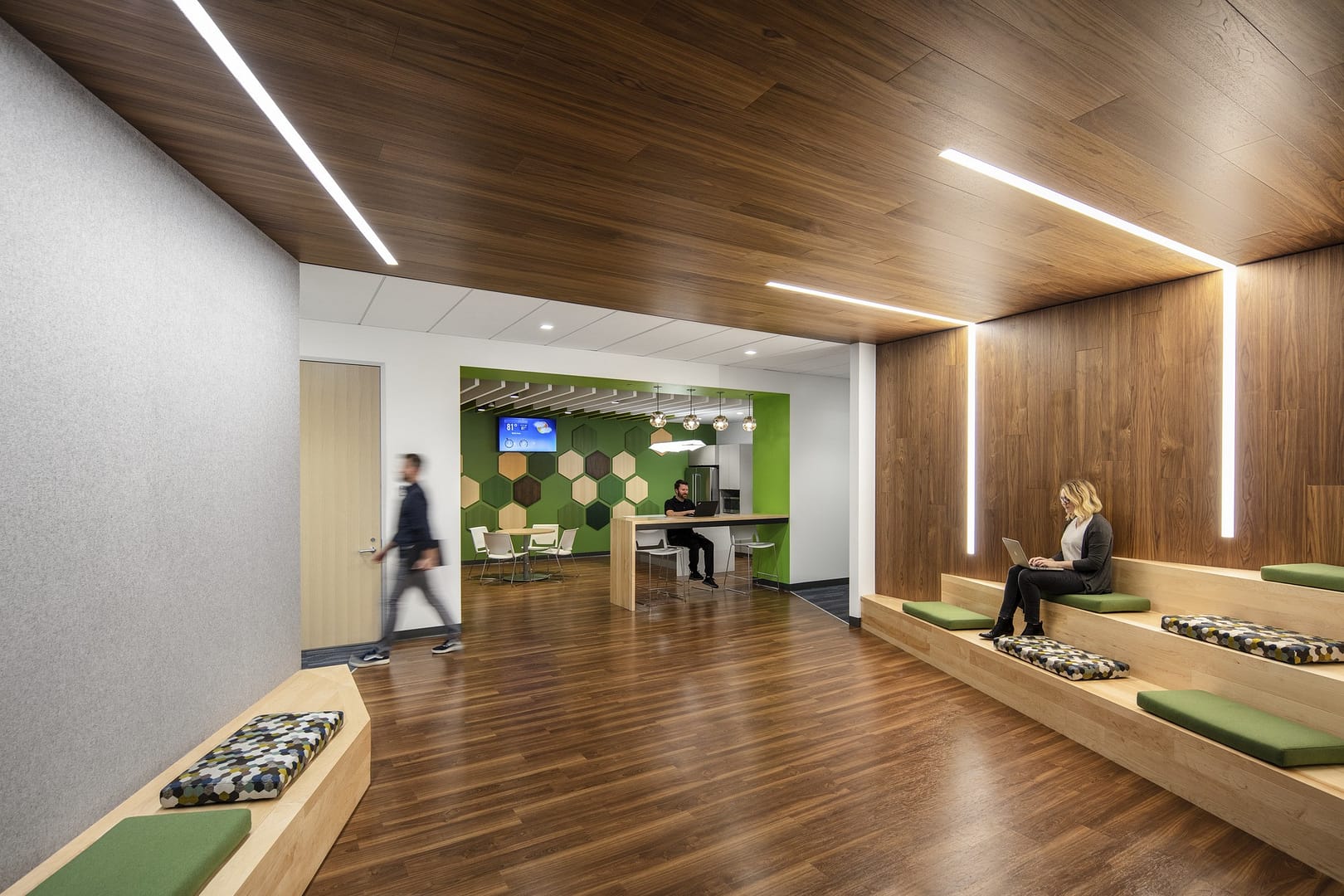
The study suggests that different lighting conditions are optimal for the completion of different task types. Analog Devices, Santa Clara, CA. Photography © Jason O’Rear.
A recent study out of the School of Design of Shanghai Jiao Tong University published in Indoor and Built Environmen explores the impact of specific lighting conditions on different work types.
The Experiment
Using a climate-, light-, and acoustically-controlled room in a “Climate Chamber” housed on the campus, researchers were able to test how participants performed under different lighting and acoustic conditions. After being given time to acclimate to a particular lighting environment, each participant was asked to complete a variety of tasks that included memory testing, picture recognition, arithmetic, reaction time, and a survey describing their comfort level in completing those tasks. Because these tests were designed to measure memory, visual performance, spatial orientation, and thinking, they were referred to as “neuro-behavioral test items.” In addition, researchers collected a sample of the participant’s tears (tear mucus), knowing that recent research suggests that the crystallization of said tears would correspond to the level of eye fatigue or visual discomfort felt by each participant.
All participants were subjected to comparable neuro-behavioral tests under different lighting conditions while factors such as humidity, temperature, and more were kept uniform. In this way, the study was able to isolate how each of three specific lighting variables impacted productivity.

Illuminance, one of the variables tested in the study, measures the brightness of a light source relative to the surface area it is illuminating.Illuminance is one of many measures of lighting output that can be applied to the workplace. Confidential Client, Chicago, IL. Photography © Garrett Rowland.
The Lighting Conditions:
When researchers manipulated the lighting conditions, they specifically altered the following three variables:
ILL (Illuminance) — Illuminance is the total measurable value of lighting output on a surface, per unit area. In other words, it is a measure of how “bright” a light source can make a specific surface area.
U-ILL (Uniformity of Illuminance)—Measures the consistency of illuminance over a given surface area. In the study, this was measured by creating a ratio of the lowest illuminance found on the surface area to the average illuminance found on the participants’ desks.
CCT (Correlated Color Temperature)—The hue and saturation of light (the color) measured without taking illuminance into consideration (brightness). This is generally measured in K (Kelvin).
The Results
By testing multiple lighting variables at once, the researchers were able to come to a variety of conclusions about lighting conditions.
- Testing illustrated that illuminance (ILL) was the most influential condition, followed by correlated color temperature (CCT), and then uniformity of illuminance (U-ILL).
- The results were fairly consistent across all of the self-evaluations in determining the perceived optimal levels for each of the variables. Respondents felt most productive, alert, and efficient under the following conditions:
Variable/Condition | Metric | Relative Intensity |
|---|---|---|
Illuminance (ILL) | 2,500 lux | high |
Uniformity of Illuminance (U-ILL) | 6 | high |
Correlated Color Temperature (CCT) | 6,500k | medium |
- Since researchers measured three different types of information (neuro-behavioral testing, self surveys, and tear film crystallization), they were also able to notice that there were times when respondents stated they felt more productive, but when the results showed that they were actually performing at their least accurate levels. This happened when there were high levels of ILL, U-ILL, and CCT.
- Contrary to prior research, tear film crystallization (the way in which tears dry, and a recently rediscovered measure of visual discomfort) had little relationship to work performance. That said, there were some instances where “better” tear film crystallization corresponded to improved task performance in memory and visual perception.
- Perhaps the most interesting discovery, researchers found that different lighting conditions proved beneficial to different neuro-behavioral tests.
Skill Tested | Optimal ILL Level | Optimal U-ILL Level | Optimal CTT Level |
|---|---|---|---|
Perception | high | high | medium |
Memory and Learning | high | high | low |
Thinking and executive functions | low | low | medium |

The study notes that environments with low illuminance levels (often found when overhead lighting is particularly distant or near larger surface areas) are ideal for decision making and executive thinking. Cogentrix, Charlotte. Photography © Mark Herboth.
The Implications
The study acknowledges that there are many ways in which future studies can improve upon their research (such as larger sample sizes and a testing group that is closer in age to the average workplace, as all participants were between 22 and 27 years of age). Still, many of the study’s findings have practical implications in the arena of workplace design.
- The study makes a strong argument for the creation of “personalized illumination environments.” As mentioned before, it was found that different lighting environments were optimal for different types of work. Knowing this, lighting designers can create environments that can be customized for times when users are engaging in learning and memory versus decision-making or more visual work. This correlates to prior studies that show that color temperature and illuminance can impact moods and behaviors in the workplace.
- These lessons on lighting diversity can also be applied to flexible workplaces, where certain spaces might be designed specifically for learning (e.g. training areas and presentation spaces) or more creative work (brainstorming rooms or small group huddle areas) where perception and visual acuity are more important.
- Knowing that test subjects had improved thinking and executive functions in low-ILL, low U-ILL environments, workplace designers and architects should consider how this informs the creation of executive offices, board rooms, and other decision-making spaces. The research indicates that these spaces can support light fixtures that are further away (higher) from the immediate work area. Lighting in these areas might benefit from having a lower color temperature (more orange or red in hue).
- Knowing the levels of illuminance and color temperature means that workplace and facilities managers are able to evaluate to some degree the quality of their lighting environment given the work being done there.
Conclusion
If an organization is able to measure the ROI of incremental improvements in efficiency, it stands to reason that this study would allow facilities managers to correlate the creation of customizable lighting environments (with the proper change management) to increased profitability. While further research is needed to see how the results vary among different demographics, it can be said with certainty that different types of work call for different lighting solutions.
IA is a global firm of architects, designers, strategists, and specialists. We focus exclusively on environments through the lens of interior architecture—a radical idea in 1984, when IA was founded. We are highly connected agents of change, committed to creativity, innovation, growth, and community.
IA is a global firm of architects, designers, strategists, and specialists. We focus exclusively on environments through the lens of interior architecture—a radical idea in 1984, when IA was founded. We are highly connected agents of change, committed to creativity, innovation, growth, and community.
